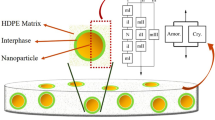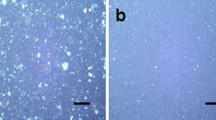Abstract
The present study suggests a new approach, based on the utilization of temperature modulated differential scanning calorimetry (TMDSC) technique, for identifying and characterizing the organic–inorganic interphase of two materials: an epoxy–fumed silica nanocomposite and a thermoplastic polyurethane (TPU)–multiwalled nanotube (MWNT) composite. The approach used here makes use of TMDSC data and basically consists of using the phase angle or the derivative of the reversing heat flow instead of the reversing heat flow curve itself. In the case of epoxy–fumed silica composites, two glass transition regions were identified. The glass transition temperature (T g) of the composite was observed to vary as a consequence of the filler content. This study shows that the T g variation is due to the formation of an organic–inorganic interphase, with its own glass transition temperature, which is different from the epoxy matrix T g. In the case of TPU–MWNT composites, two relaxations and an additional first order transition were observed: the first relaxation corresponds to the hard segment, the second is related to an interaction between filler and matrix and the third process may be connected to the partial melting of the hard segment. The addition of 0.5 wt% MWNT causes a small reduction in T g of the TPU. A major nanotube addition, 10 wt%, induces the appearance of a new relaxation that may be associated with the existence of an interface. In general, a better separation between the matrix and interphase glass transitions was obtained by the TMDSC phase angle signal.







Similar content being viewed by others
References
Wetzel B, Haupert F, Zhang MQ. Epoxy nanocomposites with high mechanical and tribological performance. Compos Sci Technol. 2003;63:2055–206.
Park JH, Jana SC. The relationship between nano- and micro-structures and mechanical properties in PMMA–epoxy–nanoclay composites. Polymer. 2003;44:2091–100.
Han J, Cho K. Nanoparticle-induced enhancement in fracture toughness of highly loaded epoxy composites over a wide temperature range. J Mater Sci. 2006;41:4239–45.
Drzal LT, Rich MJ, Koenig MF, Lloyd PF. Adhesion of graphite fibers to epoxy matrices. II. The effect of fiber finish. J Adhes. 1983;16:133–52.
Schadler LS. Polymer-based and polymer-filled nanocomposites. In: Ajayan PM, Schadler LS, Braun PV, editors. Nanocomposite science and technology. Weinheim: Wiley; 2003. pp. 77–135.
Prime RB. Thermosets. In: Turi E, editor. Thermal characterization of polymeric materials. 2nd ed. San Diego: Academic Press; 1997. pp. 1380–766.
Tarrío-Saavedra J, López-Beceiro J, Naya S, Gracia C, Artiaga R. Controversial effects of fumed silica on the curing and thermomechanical properties of epoxy composites. Express Polym Lett. 2010;4:382–95.
Tarrio-Saavedra J, López-Beceiro J, Naya S, Artiaga R. Effect of silica content on thermal stability of fumed silica/epoxy composites. Polym Degrad Stab. 2008;93:2133–7.
Huang GC, Lee JK. Isothermal cure characterization of fumed silica/epoxy nanocomposites: the glass transition temperature and conversion. Compos Part A Appl Sci Manuf. 2010;41:473–9.
Thomas LC. An introduction to the techniques of differential scanning calorimetry (DSC) and modulated DSC. In: Artiaga R, editor. Thermal analysis. Fundamentals and applications to material characterization. A Coruña: Publicaciones de la Universidade da Coruña; 2005. pp. 9–25.
Reading M, Hourston DJ. Modulated temperature differential scanning calorimetry: theoretical and practical applications in polymer characterisation. Dordrecht: Springer; 2006.
Artiaga R, García A. Fundamentals of DMA. In: Artiaga R, editor. Thermal analysis. Fundamentals and applications to material characterization. Coruña: Publicaciones de la Universidade da Coruña; 2005. pp. 183–206.
Chartoff RP, Menczel JD, Dillman SH. Dynamic mechanical analysis (DMA). In: Menczel JD, Prime RB, editors. Thermal analysis of polymers: fundamentals and applications. San Jose: Wiley; 2009. pp. 387–496.
Donth E. The glass transition. Relaxation dynamics in liquids and disordered materials. Berlin: Springer; 2001.
Menczel JD, Judovits L, Prime RB, Bair HE, Reading M, Swier S. Differential scanning calorimetry (DSC). In: Menczel JD, Prime RB, editors. Thermal analysis of polymers: fundamentals and applications’. New York: Wiley; 2009. pp. 7–239.
Van Assche G, Van Hemelrijck A, Rahier H, Van Mele B. Thermochim Acta. 1997;304(305):317.
Gracia-Fernández C, Gómez-Barreiro S, López-Beceiro J, Tarrío-Saavedra J, Naya S, Artiaga R. Comparative study of the glass transition temperature by DMA and TMDSC. Polym Test. 2010;29:1002–6.
Koberstein JT, Galambos AF, Leung LM. Compression-molded polyurethane block copolymers. 1. Microdomain morphology and thermomechanical properties. Macromolecules. 1992;25:6195–204.
Chen TK, Shieh TS, Chui JY. Studies on the first DSC endotherm of polyurethane hard segment based on 4,4′-diphenylmethane diisocyanate and 1,4-butanediol. Macromolecules. 1998;31:1312–20.
Tien YI, Wei KW. The effect of nano-sized silicate layers from montmorillonite on glass transition, dynamic mechanical, and thermal degradation properties of segmented polyurethane. J Appl Polym Sci. 2002;86:1741–8.
Chen TK, Chui JY, Shieh TS. Macromolecules. Glass transition behaviors of a polyurethane hard segment based on 4,4′-diisocyanatodiphenylmethane and 1,4-butanediol and the calculation of microdomain composition. Macromolecules. 1997;30:5068–74.
Xia H, Song M. Preparation and characterization of polyurethane–carbon nanotube composites. Soft Matter. 2005;1:386–94.
Xia H, Song M. Preparation and characterisation of polyurethane grafted single-walled carbon nanotubes and derived polyurethane nanocomposites. J Mater Chem. 2006;16:1843–51.
Koerner H, Price G, Pearce NA, Alexander M, Vaia RA. Remotely actuated polymer nanocomposites—stress-recovery of carbon-nanotube-filled thermoplastic elastomers. Nat Mater. 2004;3:115–20.
Cho JW, Kim JW, Jung YC, Goo NS. Electroactive shape-memory polyurethane composites incorporating carbon nanotubes. Macromol Rapid Commun. 2005;26:412–6.
Zhang H, Zhang Z, Friedrich K, Eger C. Property improvements of in situ epoxy nanocomposites with reduced interparticle distance at high nanosilica content. Acta Mater. 2006;54:1833–42.
Liu YL, Wei WL, Hsu KY, Ho WH. Thermal stability of epoxy–silica hybrid materials by thermogravimetric analysis. Thermochim Acta. 2004;412:139–47.
Preghenella M, Pegoretti A, Migliaresi C. Thermomechanical characterization of fumed silica–epoxy nanocomposites. Polymer. 2005;46:12065–72.
Yousefi A, Lafleur PG, Gauvin R. Kinetic studies of thermoset cure reactions: a review. Polym Compos. 1997;18:157–68.
Naya S, Martínez-Vilariño S, Artiaga R. Efecto de ciclos térmicos en la permeabilidad y propiedades térmicas de compuestos nanoarcilla-epoxi. Dyna’s J. 2009;84:71–6.
Pellín MP, Regueira LN, Quintela AL, Losada PP, Gándara JS, Abuín SP. Epoxy resins based on trimethylolpropane. II. Kinetic and thermodynamic parameters of cure with m-XDA. J Appl Polym Sci. 1995;55:1507–16.
Quintela AL, Pellin MP, Abuin SP. Epoxidation reaction of trimethylolpropane with epichlorohydrin: kinetic study of chlorohydrin formation. Polym Eng Sci. 1996;36:568–73.
Jena PK, Brocchi EA, Solórzano IG, Motta MS. Identification of a third phase in Cu–Al2O3 nanocomposites prepared by chemical routes. Mater Sci Eng A Struct Mater Prop Microstruct Process. 2004;371:72–8.
Kim D, Lee JS, Barry CMF, Mead JL. Microscopic measurement of the degree of mixing for nanoparticles in polymer. Nanocomposites by TEM images. Microsc Res Tech. 2007;70:539–46.
Reed KE. Dynamic mechanical analysis of fiber reinforced composites. Polym Compos. 1980;1:44–9.
Ruppert D, Sheather SJ, Wand MP. An effective bandwidth selector for local least squares regression. J Am Stat Assoc. 1995;90:1257–70.
Finnigan B, Halley P, Jack K, McDowell A, Truss R, Casey P, Knott R, Martin D. Effect of the average soft-segment length on the morphology and properties of segmented polyurethane nanocomposites. J Appl Polym Sci. 2006;102:128–39.
Kultys A, Rogulska M, Pikus S, Skrzypiec K. The synthesis and characterization of new thermoplastic poly(carbonate-urethane) elastomers derived from HDI and aliphatic–aromatic chain extenders. Eur Polym J. 2009;45:2629–43.
Fernández M, Landa M, Muñoz ME, Santamaría A. Thermal and viscoelastic features of new nanocomposites based on a hot-melt adhesive polyurethane and multi-walled carbon nanotubes. Macromol Mater Eng. 2010;295:1031–41.
Fernández I, Santamaría A, Muñoz ME, Castell P. A rheological analysis of interactions in phenoxy/organoclay nanocomposites. Eur Polym J. 2007;43:3171–6.
Acknowledgements
This research has been partially supported by the Spanish Ministry of Science and Innovation, Grant MTM2008-00166 (ERDF included) and Grant MTM2011-22393. The authors thank Senén Paz for constructive comments and the referees for their valuable suggestions.
Author information
Authors and Affiliations
Corresponding author
Rights and permissions
About this article
Cite this article
Tarrío-Saavedra, J., Gracia-Fernández, C., López-Beceiro, J. et al. TMDSC phase angle for a better nanocomposite interphase identification. J Therm Anal Calorim 109, 1277–1284 (2012). https://doi.org/10.1007/s10973-012-2568-z
Published:
Issue Date:
DOI: https://doi.org/10.1007/s10973-012-2568-z




